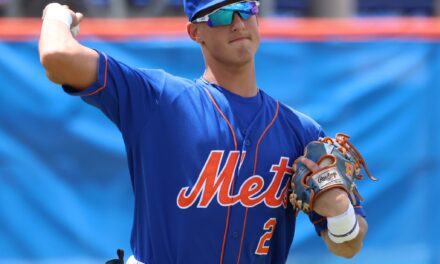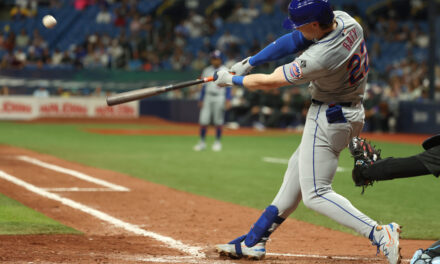
I hadn’t given it much thought until it became clear that the interest in free agent center fielder Michael Bourn was more than just passing. I don’t really think that Bourn’s price will drop into a range the Mets are comfortable with, and if it does, that would probably invite more teams to take a shot at him. There’s also the little matter of the draft pick. I’m torn between whether I think the league would cave or not. Normally I’d say no chance, but Uncle Bud has given the Mets more than plenty special dispensations in recent history. Maybe they would allow the Mets to keep their pick. I say it’s moot, however, because again, I don’t think the Mets have a legitimate shot at acquiring Bourn.
And that means they keep their pick. I’ve been adamant that the pick shouldn’t be what holds the Mets up in their pursuit of Bourn (the terms of the contract should be the only thing), and I’m on record here at MetsMerized saying that Bourn will be better for the Mets than whomever the Mets might draft. On the right deal, I stand by that. But the sentiment inspired me to look around the draft blogs to see who the mocks had the Mets drafting.
There are a lot of mocks.
I ignored any on Bleacher Report, any from team fan sites and any from websites I’ve never heard of. Selective as it may be, if I’ve never heard of them, I can’t vouch for them and wouldn’t feel comfortable taking their word. That left me with the mocks from www.minorleagueball.com and www.mymlbdraft.com. And as luck would have it, both drafts have the Mets taking Florida Gator Jonathan Crawford at #11.
You may remember seeing Crawford’s name after he tossed the seventh no-hitter in the history of the NCAA tournament this past June. He is a 21-year-old sophomore listed at 6’-1” and 205 pounds. I came across the scouting report on Crawford from ProScouting to see what they have to say about Crawford and liked what I saw.
Proscouring.com uses the 20-80 scale when evaluating talent and offers a number for both their current level and where the scouts envision them to peak as a major leaguer. These numbers are categorized as “current” and “OFP” (overall future performance/potential). The scale is defined as:
70+: MVP, Perennial All-Star – Frontline ace pitcher; superstar position player
60-69: Above average, All-Star caliber – #1 or #2 pitcher; position player among the best
55-59: Solid MLB player – #3 or #4 pitcher or top middle relief; solid starting position player
50-54: Average MLB player – Back end starter, average relief; position player that could start on most teams.
45-49: Backup – Spot starter, fair relief; utility/bench player
40-44: Fringe player – Up and down, could make the team for lower-tier club
30-39: AA or AAA – Emergency call-up
20-29: Low minors
For pitchers, ProScouting grades the fastball on velocity, movement and command. The offspeed grade combines all the offspeed pitches the pitcher offers. Finally, the peripherals accounts for smarts, control, deception, release point, arm action, physical maturity (is he filled out, or still growing?), injury history and intangibles.
ProScouting likes Crawford and here’s how he rates (Current/OFP) with some paraphrased comments:
Fastball (55/60): Four-seamer is the out pitch, touches 96-98, sits at 94 with plus movement and future command. Power stuff and arm projects well for a closer role if other aspects don’t pan out.
Offspeed (38/53): Hard slider with sharp break. Inconsistent command, but a plus pitch when in the zone. Basic feel for major league change. Good arm speed and deception. Throws for strikes.
Peripherals (45/57): Three potential plus pitches. Close to average control already, especially with fastball. Can be dominant if/when he masters slider and change. Plus deception with easy, clean delivery with plus arm speed. Ball jumps on hitter. Solid mechanics and delivery.
I should add that these mocks are obviously very early, since the 2013 college season hasn’t begun yet. Draft position will depend on this season and could slide in either direction. A great season for Crawford, especially if he shows improvement on his offspeed pitches, could move him up and off the board at #11. A poor season and he could drop.
So keep an eye out for Jonathon Crawford’s 2013 season. If that’s how it all shakes out, given his age and college experience, he could be ready to see major league action around the same time as Noah Syndergaard is expected to, but there’s a million things that can change between now and the draft.















